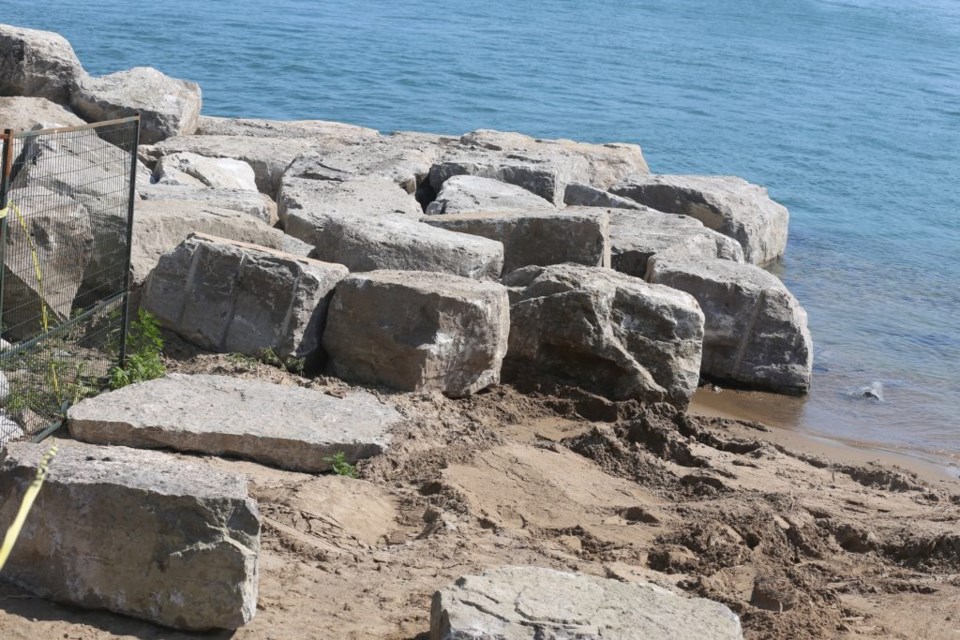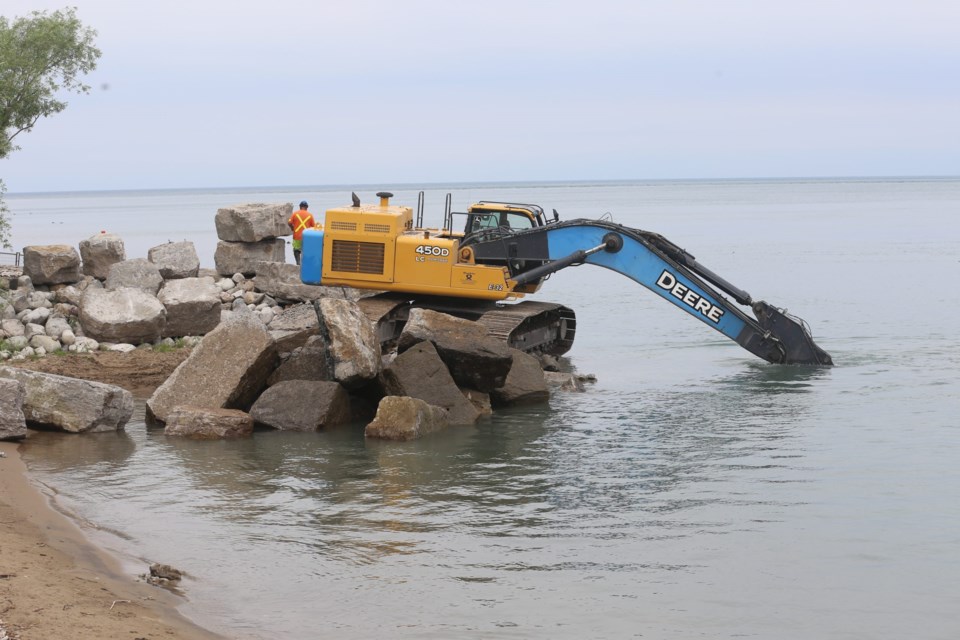It took just a day’s work to repair damages to the large stone barrier provid ing shoreline protection to Balls Beach Park, but it’s only a temporary fix to ensure the area is safe for those walking and climbing on the rocks.
Following an “incident that led to an unfortunate groyne (rock structure) failure” at the park, town staff “took immediate action to ensure public safety in the area,” says a town news release issued last Friday, including putting up barricades, caution tape, onsite signage, and hiring a security guard to prevent access into the rock area, which was originally intended to protect the shoreline and to provide a safe area to walk. That was followed by some work at the park Saturday to retrieve the rocks and put them back in place to once again make the area safe, while a permanent solution is designed.
Rankin Construction was able to complete the work of repositioning and flattening the unstable rocks Saturday. The objective, the town news release said, was for the beach to be open and safe for public use before the Canada Day long weekend.
The town’s engineering consultant was going to oversee the works, and town staff onsite “periodically,” said CAO Marnie Cluckie, with a report back to staff expected once the area is deemed safe for public use.
The “incident” the town’s statement referred to, that caused the unsafe conditions, took place overnight March 14, when a storm washed away some of the sand the large anchor stones were sitting on, and one of the stones was completely swept away.
It was sitting in deep water, partially buried in sand, says Ron Simkus, a retired mining engineer and Dock Area resident who monitors the water level and wave action at the beach.
He said more than a year ago that the scenario at Balls Beach is very different from all but a very few other locations, with issues that result from a river and lake meeting.
“There are a number of things that come into play here,” he says, and they create a much larger challenge than would be encountered when designing shoreline protection for either a lakefront or a river, rather than the meeting of both.
He recalls being quoted on the front page of The Local in February, 2020, warning of just such an outcome, when engineers were deciding what to do with the waterfront.
He said then the groyne appeared to be collapsing into the lake, and that there was likely a drop-off in the lake bottom. The concept of the groyne was outdated and enormously expensive, he said, and suggested the town look at other alternatives.
“I don’t want to say ‘I told you so,’ I didn’t want to be right. I was right, but I’m not pleased about it,” he says now.
The problem is there are solutions that can be designed for a lakeshore, or for a riverbank. But the solution the experts determined was suitable for Balls Beach turned out not to be, as Simkus warned.
He refers to the area of the beach as a hybrid situation, with a large river — one of the largest in the world — meeting a large lake, and creating the back eddy that kayakers and sailors have long recognized as the place where the current reverses direction and flows upstream. “There are only a handful of places like that in the world,” he says. “It splays left and right and backwards, and it turned out to be more powerful than anybody thought it was. They knew about it, but they didn’t think it was as big a deal as it turned out to be.”
The work that was carried out Saturday “went really well,” he says, creating a box for the stones that are there, on or hugging the shoreline.

Once the engineer in charge signed off that it was safe, the fence was removed Tuesday, the security guard sent home and the area was open again for walking.
But to find a permanent solution, a forensic analysis will have to be done to solve the mystery of what happened the night of March 14, says Simkus.
Although there was wind and rain that night, it wasn’t a particularly ferocious storm, and the water levels were not high — they were similar to those in the summer of 2016, before the record high levels of 2017 that caused so much damage the town began working on a plan for shoreline protection.
“The parameters in March were not extraordinary. That’s the mystery that has everybody foiled.”
Yet the waves that night sloughed the sand away from under the anchor stone groyne to make it unstable, with some of the rocks toppling, and one washing away quite a distance and sinking in the sandy bottom.
Some of them were retrieved and put back in place Saturday, Simkus says, with one requiring the excavator to reach as far out and as deeply as it could go.
Any final solution, he says, has to respect the back eddy, or the damage will be repeated.
“There will be a lot of people demanding a guarantee, assurances that it will not happen again,” he says, “and there will be meetings of all parties to explore what has happened and how to go forward. But nobody is standing with their hand on their heart promising to have the solution.”
He suggests what might be necessary is “a line in the sand, beyond which you can’t go.”
The town should be looking for a solution that is pragmatic, not outrageously expensive, and that accepts there will always be wave action “more powerful than we can defend against.”
There will always be waves coming over the top of the rocks during high water, he says, and what is pragmatic “may be a deterrent, not a solution.”
